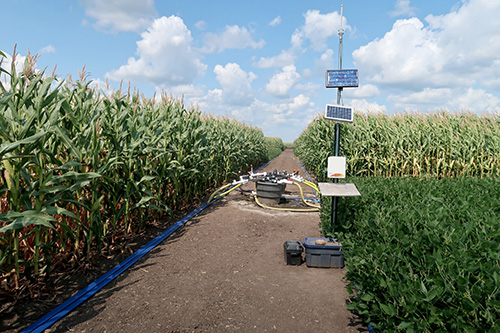Hot and dry. Those words describe the 2021 growing season here at the Southwest Research and Outreach Center, as well as across much of Minnesota.
Redwood County, where the SWROC is located, spent much of the summer in the U.S. Drought Monitor’s moderate and extreme drought categories, with portions of the county reaching extreme drought levels at the end of July.
While the drought’s impact can only be seen as a negative for most corn and soybean growers in the region, the dry growing season presented exciting research opportunities for Professor Jeff Strock, who conducts drainage water quality research at the SWROC.
“It’s been a welcome year for our research, honestly. 2016 through 2019 were so wet that we were scrambling to take and process water samples,” Strock explains. “In this dry year, we were able to implement an irrigation project that I’ve wanted to work on for years and collect valuable water quality data.”
The dry conditions allowed Strock to study drainage water recycling, a practice that uses drainage water held in a pond at the edge of a field to irrigate crops. Plots in the irrigation study were under three treatments - rainfed, full irrigation, and limited irrigation.
The SWROC weather station recorded a mere 4.4” of rain from the beginning of May to the end of July, creating an environment where irrigation can be especially impactful. As expected, there have been striking visual differences between the plots that are rainfed and those that are irrigated.
“We’ve seen really big differences in the performance of the crop in terms of water use and crop growth. Yield is still to be determined but we’re anticipating that the negative impact of the hot, dry conditions will be reflected in the rainfed plots and the irrigated plots will have improved yields.”
June was especially hot and dry at the SWROC - a staggering 0.49” of precipitation was recorded during the entire month coupled with high daily temperatures, including an 8-day stretch where temperatures reached above 90ºF each day.
These extreme conditions allowed Strock to look at how the corn and soybean crops in his study respond to both heat and dry stress at the same time.
“We’ve been measuring leaf canopy temperature during the heat of the day as well as at night. Where we have no irrigation, plants go into stress earlier and quicker than irrigated plants and then stay in a stressed state longer.”
Minnesota’s drought-stressed crops aren’t producing record-breaking yields for farmers, but they are providing researchers like Strock with valuable data to help understand how plants respond to drought. This data will help develop management practices that can minimize the negative impacts of future droughts for area farmers.

